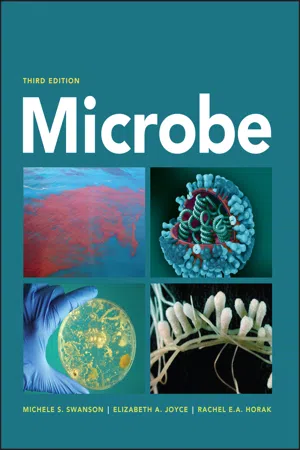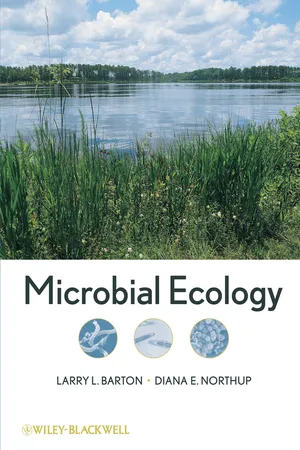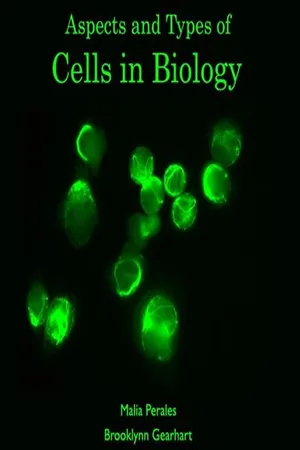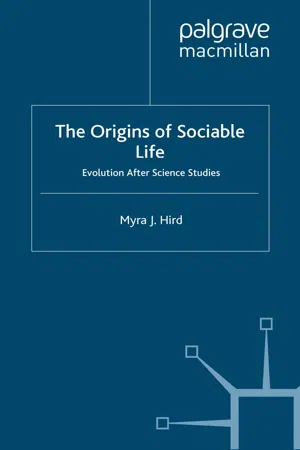Biological Sciences
Archaea vs Bacteria
Archaea and Bacteria are two distinct domains of single-celled microorganisms. While both are prokaryotes and share some similarities, they differ in genetic makeup, cell membrane structure, and metabolic processes. Archaea are known for thriving in extreme environments, such as hot springs and deep-sea hydrothermal vents, while Bacteria are more widespread and can be found in various habitats, including soil, water, and living organisms.
Written by Perlego with AI-assistance
Related key terms
1 of 5
8 Key excerpts on "Archaea vs Bacteria"
- eBook - PDF
- Dave Wessner, Christine Dupont, Trevor Charles, Josh Neufeld(Authors)
- 2020(Publication Date)
- Wiley(Publisher)
In fact, the entire story of the domain Archaea is somewhat hard to imagine. For many years, cultured members of this domain were lumped together with bacteria into a single kingdom. Indeed, archaea bear striking similarities to bacteria. Most notably, archaea and bacteria are very similar in size and have chromosomes of similar size and organization. Members of both groups also lack a membrane‐bound nucleus. Despite these super- ficial similarities, genetic studies have revealed that bacteria and archaea form two highly distinct evolutionarily groups. Additional studies have provided more evidence that archaea differ substantially from both bacteria and eukarya. In Section 4.2, we will examine the structure of archaeal cells, focusing on how common structures differ among archaea, bacteria, and eukarya. In this section, we will focus on a more fundamental question. How do we know that Archaea is a distinct domain of life? Phylogeny The question posed above can best be answered by phyloge- netic studies, or studies of the evolutionary relatedness of organisms. The question, then, becomes: How can we deter- mine the evolutionary relatedness of all living organisms? In 1977, while Carl Woese and George Fox were research- ers at the University of Illinois at Urbana‐Champaign, they 112 CHAPTER 4 Archaea Yersinia Pseudomonas Rickettsia Clostridium Bacillus Staphylococcus Streptococcus Mycoplasma Borrelia Methanothermobacter Methanosarcina Methanococcus Methanocaldococcus Vibrio Haemophilus Bordetella Neisseria Mycobacterium Chlamydia Bacteroides Thermatoga FIGURE 4.2 Methanogens are genetically distinct from bacteria In 1977, Woese and Fox proposed that methanogens were distinct from all commonly known bacteria. Subsequent SSU rRNA gene sequence analysis has confirmed this hypothesis. As shown in this schematic, when the 16S rRNA sequences of various bacteria and the four methane-producing microorganisms are compared, the methanogenic species form a distinct cluster. - eBook - PDF
- Michele S. Swanson, Elizabeth A. Joyce, Rachel E. A. Horak(Authors)
- 2022(Publication Date)
- ASM Press(Publisher)
• Identify reasons why Archaea were undiscovered until the advent of molecular biology and why the diversity of extant Archaea is still being discovered. • Describe the role of methanogens in the carbon biogeochemical cycle. • Use extreme halophiles as an example to justify the statement: “The survival and growth of any microorganism in a given environment depend on its metabolic characteristics.” 358 | PART II MICROBIAL DIVERSITY Until significant amounts of information about DNA and protein sequences became available in the 1970s, there was no rational basis for assigning Bacteria or Archaea to phylogeny-based taxa. Now, the wealth of available sequence information makes the study of evolutionary relationships possible. Conservative estimates are that the number of yet-uncultivated bacterial phyla may be greater than 1,300. The analysis of microbial mats from a single site in Mexico alone produced 43 bacterial novel phyla. Environmental surveys indicate that archaea are also metabolically diverse and, consequently, ubiqui- tous and abundant. Some scientists estimate that the number of uncultivated archaeal phyla may be as high as that for bacteria. How then do we make order of this incredible prokaryotic diversity? As a guide, we will use the taxonomic classification shown in Fig. 14.2, which starts with the upper domain level (Bacteria or Archaea) and then narrows the evolu- tionary relatedness of these microbes down to the species levels. So great is the diversity even at the phylum level that we will focus on selected phylum-level clades only. Bacteria The domain Bacteria was long believed to be the largest and most complex of the two domains of anucleate microbes. However, the perceived difference might be greater than the actual one because new species and groups of Archaea continue to be discovered. The domain is further divided into several phyla (Fig. 14.3), but many more are believed to exist. The size of each bacte- rial phylum varies enormously. - eBook - ePub
- Larry L. Barton, Diana E. Northup(Authors)
- 2011(Publication Date)
- Wiley-Blackwell(Publisher)
In general, bacteria in environmental studies are more diverse than archaea in the same environment, with some exceptions reviewed in Aller and Kemp (2008) (plankton, arsenite-oxidizing acidic thermal springs, subsurface hot springs, and methane-rich sediments of a hydrocarbon seep). Aller and Kemp (2008) speculate that this difference in diversity may be due to how archaea live in the environment, the energetic costs of their metabolism, and their metabolic flexibility, suggesting that many members of the Domain Bacteria are more flexible in less extreme environments. The degree to which archaeal and bacterial species are interlinked within an environment is not known and may shed light on the diversity of these two groups. In addition to possible differences in diversity, there are fundamental cellular and genomic differences, which help to elucidate archaeal evolution.2.7 Archaea–Bacteria DifferencesYou may have already noticed in the earlier sections that archaea and bacteria show major ecological differences and similarities. They also differ substantially at the cellular and genomic levels. The archaea have been shown to have a chimeric nature. Despite their bacteria-like morphology, they show great similarities to the eukarya in their transcription, translation, DNA repair, RNA polymerase, replication, and basal promoter sequences. A surprise finding was that members of the euryarchaeotal branch of the Archaea domain posses homologs of the eukaryotic histones. One of their fundamental differences from the bacteria is that their cell membranes contain isoprene sidechains that are ether-linked to glycerol. Archaeal cell walls are composed of glycoprotein, protein, and pseudomurein (but not murein), and their anitibiotic sensitivity differs from bacterial antibiotic sensitivity. Some energy metabolism methods are unique to the archaea, such as methanogenesis. Overall, archaeal core housekeeping and metabolic functions are similar to bacterial ones, while their information-processing systems are more eukaryotic (Allers and Mevarech 2005; Schleper et al. 2005).2.8 Eukarya: A Changing Picture of Phylogenetic DiversityThe phylogeny of the eukarya has undergone and is undergoing many revisions based on new discoveries. Previously, several phyla of protists diverged at the base of the tree and several of these protists were believed to lack mitochondria (i.e., amitochondriate). This earlier phylogeny was based on 18S rDNA sequence analysis. New phylogenetic trees, based on other genes and proteins, suggest that these protists were not basal as originally thought, and the eukaryotic phylogeny is currently under revision (Parfrey et al. 2006). New findings now show that these groups, which include eukaryotes such as Giardia (a diplomonad), Trichomonas (a parabasilid), and Encephalitozoon (a microsporidian), have mitochondria-like proteins called mitosomes - No longer available |Learn more
- (Author)
- 2014(Publication Date)
- College Publishing House(Publisher)
Woese argued that this group of prokaryotes is a fundamentally different sort of life. To emphasize this difference, these two domains were later renamed Archaea and Bacteria. The word archaea comes from the Ancient Greek ἀ ρχα ῖ α, meaning ancient things. At first, only the methanogens were placed in this new domain, and the archaea were seen as extremophiles that exist only in habitats such as hot springs and salt lakes. By the end of the 20th century, microbiologists realized that archaea is a large and diverse group of organisms that are widely distributed in nature and are common in much less extreme habitats, such as soils and oceans. This new appreciation of the importance and ubiquity of archaea came from using the polymerase chain reaction to detect prokaryotes in samples of water or soil from their nucleic acids alone. This allows the detection and identification of organisms that cannot be cultured in the laboratory, which generally remains difficult. Current classification The classification of archaea and of prokaryotes in general, is a rapidly moving and contentious field. Current classification systems aim to organize archaea into groups of organisms that share structural features and common ancestors. These classifications rely heavily on the use of the sequence of ribosomal RNA genes to reveal relationships between organisms (molecular phylogenetics). Most of the culturable and well-investigated species of archaea are members of two main phyla, the Euryarchaeota and Crenarchaeota. Other groups have been tentatively created. For example, the peculiar species Nanoarchaeum equitans , which was discovered in 2003, has been given its own phylum, the Nanoarchaeota. A new phylum Korarchaeota has also been proposed. It contains a small group of unusual thermophilic species that shares features of both of the main phyla, but is most closely related to the Crenarchaeota. - No longer available |Learn more
- (Author)
- 2014(Publication Date)
- Academic Studio(Publisher)
________________________ WORLD TECHNOLOGIES ________________________ Chapter 8 Archaea Archaea Temporal range: Paleoarchean – Recent Halobacteria sp. strain NRC-1, each cell about 5 μm long Scientific classification Domain: Archaea Woese, Kandler & Wheelis, 1990 Kingdoms and phyla Crenarchaeota Euryarchaeota Korarchaeota Nanoarchaeota Thaumarchaeota Aigarchaeota The Archaea are a group of single-celled microorganisms. A single individual or species from this domain is called an archaeon (sometimes spelled archeon). They have no cell nucleus nor any other membrane-bound organelles within their cells. In the past they were viewed as an unusual group of bacteria and named archaebacteria , but the Archaea have an independent evolutionary history and show many differences in their biochemistry from other forms of life, and so they are now classified as a separate domain in the three-domain system. I n this system the phylogenetically distinct branches of evolutionary descent are the Archaea, Bacteria and Eukaryota. Archaea are divided ________________________ WORLD TECHNOLOGIES ________________________ into four recognized phyla, but many more phyla may exist. Of these groups, the Crenarchaeota and the Euryarchaeota are most intensively studied. Classification is still difficult, because the vast majority have never been studied in the laboratory and have only been detected by analysis of their nucleic acids in samples from the environment. Although archaea have, in the past, been classed with bacteria as prokaryotes (or Kingdom Monera), this classification is regarded by some as outdated. Archaea and bacteria are quite similar in size and shape, although a few archaea have very unusual shapes, such as the flat and squar e-shaped cells of Haloquadratum walsbyi . - eBook - PDF
- Mary Ann Clark, Jung Choi, Matthew Douglas(Authors)
- 2018(Publication Date)
- Openstax(Publisher)
22 | PROKARYOTES: BACTERIA AND ARCHAEA Figure 22.1 Certain prokaryotes can live in extreme environments such as the Morning Glory pool, a hot spring in Yellowstone National Park. The spring’s vivid blue color is from the prokaryotes that thrive in its very hot waters. (credit: modification of work by Jon Sullivan) Chapter Outline 22.1: Prokaryotic Diversity 22.2: Structure of Prokaryotes: Bacteria and Archaea 22.3: Prokaryotic Metabolism 22.4: Bacterial Diseases in Humans 22.5: Beneficial Prokaryotes Introduction In the recent past, scientists grouped living things into five kingdoms—animals, plants, fungi, protists, and prokaryotes—based on several criteria, such as the absence or presence of a nucleus and other membrane- bound organelles, the absence or presence of cell walls, multicellularity, and so on. In the late 20 th century, the pioneering work of Carl Woese and others compared sequences of small-subunit ribosomal RNA (SSU rRNA), which resulted in a more fundamental way to group organisms on Earth. Based on differences in the structure of cell membranes and in rRNA, Woese and his colleagues proposed that all life on Earth evolved along three lineages, called domains. The domain Bacteria comprises all organisms in the kingdom Bacteria, the domain Archaea comprises the rest of the prokaryotes, and the domain Eukarya comprises all eukaryotes—including organisms in the kingdoms Animalia, Plantae, Fungi, and Protista. Two of the three domains—Bacteria and Archaea—are prokaryotic. Prokaryotes were the first inhabitants on Chapter 22 | Prokaryotes: Bacteria and Archaea 589 Earth, appearing 3.5 to 3.8 billion years ago. These organisms are abundant and ubiquitous; that is, they are present everywhere. - M. Hird(Author)
- 2009(Publication Date)
- Palgrave Macmillan(Publisher)
17 Notwithstanding recent advertisements about ‘good’ bacteria in yoghurt, I am schooled in recognizing my meetings with bacteria as military encounters – invasion and defense – between my (nonbacter- ial) individual self and disease (bacteria). That is, the pathogen matrix overwhelmingly defines the parameters of animal meetings-with bac- teria. Thus my not-species meeting-with must begin by exploring bac- teria excessive to pathogen characterization. Domains Archaea and Bacteria 18 Within the domains Bacteria and Archaea, multicellular assemblages and complex life cycles with several developmental stages are common. While knowledge accumulated so far suggests a staggering diversity within these domains, the majority of bacteria are yet to be discerned, suggesting much further diversity to come. And given that bacteria exchange genes so readily, thereby creating a new ‘mix’ each time, we might reasonably argue that there are as many kinds of bacteria as there are bacteria. The quick survey provided below falls far short of express- ing the wide range of bacteria: I provide here merely a glimpse into this majority world. Scientists distinguish between organisms on the basis of several factors, such as metabolism, motility, and reproduction. Metabolism is 26 The Origins of Sociable Life: Evolution After Science Studies crucial. All organisms on earth rely upon only two sources of energy: light energy from the sun or energy derived from chemicals. One of the major differences between bacteria and animals is that many bac- teria do not ‘eat’ in the sense that we mean it: they convert light and/or chemical energy. All animals and fungi by contrast are heterotrophs – ‘living off others’, relying upon the ingestion of other organisms and their products (more on this in Chapter 7).- eBook - PDF
- Julianne Zedalis, John Eggebrecht(Authors)
- 2018(Publication Date)
- Openstax(Publisher)
Have metabolic pathways evolved separately in Bacteria and Archaea? b. Should all methanogens be classed as Archaea in evolutionary phylogeny? c. Have methanogens evolved to live in both moderate and extreme environments? d. Did the methanogenic bacteria species also evolve as a strict anaerobe? 66. What is another question you might pose to learn more about the structural features that allow for the capture, storage, and use of free energy by archaean methanogens? 936 Chapter 22 | Prokaryotes: Bacteria and Archaea This OpenStax book is available for free at http://cnx.org/content/col12078/1.6 a. Do archaean methanogens differ from other Archaea structurally, and if so, in what way? Is one or more of these structural differences related to these methanogens’ ability to use H 2 to oxidize CO 2 ? b. Do archaean methanogens differ from other Bacteria structurally, and if so, in what way? Is one or more of these structural differences related to these methagens’ ability to use CO 2 to oxidize H 2 ? c. Do archaean methanogens differ from other Archaea structurally, and if so, in what way? Is one or more of these structural differences related to these methagens’ ability to use CO 2 to oxidize H 2 ? d. Do archaean methanogens differ from other Archaea structurally, and if so, in what way? Is one or more of these structural differences related to these methagens’ ability to use H 2 O to oxidize H 2 ? 67. Which set of phrases related to nutritional and metabolic adaptations best fits the organisms described? a. chemoautotrophs, obligate anaerobes b. chemoautotrophs, faculative anaerobes c. chemoheterotrophs, faculative anaerobes d. chemoheterotrophs, obligate anaerobes 68. In an experiment, researchers grew plant seedlings in soils to which one of two strains of bacteria were added.
Index pages curate the most relevant extracts from our library of academic textbooks. They’ve been created using an in-house natural language model (NLM), each adding context and meaning to key research topics.







